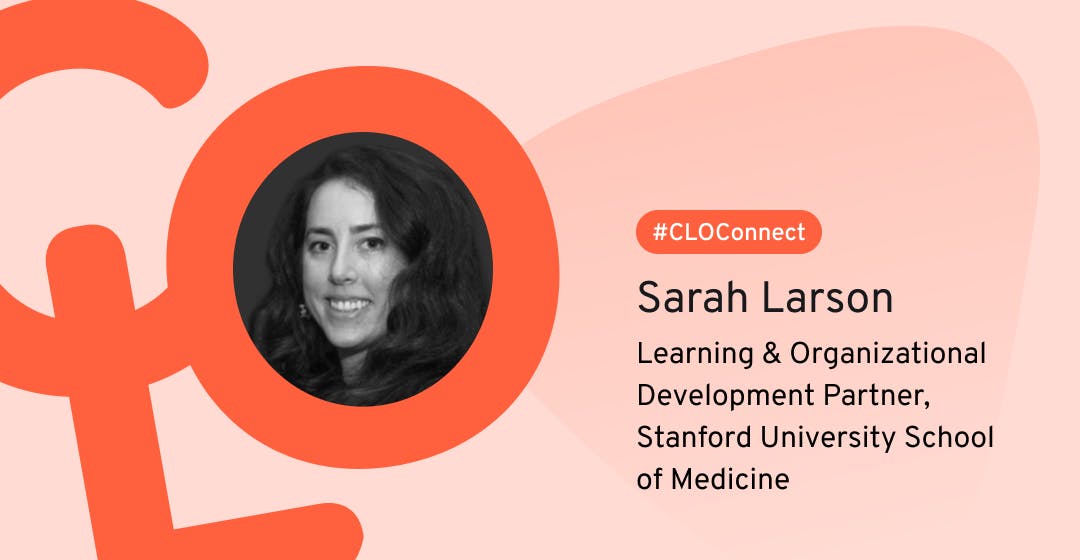
Diversity and Innovation: Stanford Medicine’s 3-Step Leadership Development Program
L&D leaders everywhere know that organizational diversity can help generate innovative ideas and create groundbreaking new initiatives.
But how do L&D teams ramp up foundational leadership skills in parts of their organization with the most diversity? And how can they encourage inner mobility to build more inclusive leadership?
These are tough questions. That’s why I was so excited, in my third healthcare L&D series interview, to speak to Sarah Larson, Learning & Organizational Development Partner at the Stanford University School of Medicine, about her three-step approach to promote diverse leadership growth within her organization.
Read on to hear how Sarah plans to change the world!
Loving what you’re reading? Come and join the L&D Collective for more great learning insights, resources, and events!
Understanding the Diversity-Innovation Paradox
Sarah started our conversation by describing learning & development at Stanford University School of Medicine–in particular, one of the biggest challenges the organization is facing.
“Basically,” she says, “we’re academic medicine–we call ourselves Stanford Medicine as a whole. We encompass the Stanford Hospital and clinics, the children's hospital, as well as other clinical opportunities along with the medical school itself.”
As she notes, this is a large operation. “It’s pretty vast. I think in total we have about 30,000 employees. The L&D team works with staff, specifically, those types of staff who are clinicians, clinician-educators, lab assistants, administrative associates, and similar roles.”
As Sarah explains, one of the challenges she believes many organizations are facing–Stanford Medicine included–is the Diversity-Innovation Paradox.
“The Diversity-Innovation Paradox occurs when stratification halts innovation,” she says. “In other words, while women and racial minorities are more likely to generate innovative ideas and initiatives, they’re less likely to benefit from their own initiatives.”
Sarah explains that stratification can be caused when a person representing a minority brings up a new idea. As she observes, sometimes these ideas can be devalued a lot easier because, for the majority, an atypical idea that falls outside the norm can be very difficult to grasp.
“This can look like a decrease in promotional opportunities or scapegoating,” says Sarah. “It can also potentially result in individuals from different backgrounds quitting their program or job. A major outcome we currently see in the workforce is the lack of diversity in leadership, particularly in sciences and health care.”
So, how did Sarah and her team set out to address the Diversity-Innovation Paradox in such a large organization? Read on to hear their effective solution.
Need a few more CLO Connect expert insights? Find out how L&D can help you build the company culture you really need.

What's company culture without L&D?
By providing your contact info, you agree to receive communications from 360Learning. You can opt-out at any time. For details, refer to our Privacy Policy.
The Diversity-Innovation Paradox occurs when stratification halts innovation. In other words, while women and racial minorities are more likely to generate innovative ideas and initiatives, they’re less likely to benefit from their own initiatives.
Stanford Medicine’s 3-step leadership, education, access, and power program
As Sarah explains, Stanford Medicine has begun to address the Diversity-Innovation Paradox through their LEAP program which promotes leadership growth from the parts of the organization with the most diversity.
“LEAP stands for Leadership, Education, Access and Power,” says Sarah. “Within this program, we place peer-to-peer accountability partners to work with learners, cultivating a foundational skillset of self-awareness, including through giving and receiving feedback. We also ensure access to the Associate Dean, who you would normally think is way too far up to be able to get in contact with and learn from.”

“With our LEAP program, we’re geared towards giving aspiring leaders the foundational power skills to fuel their leadership journey.”
So, how did Sarah and her team set out to ramp up the foundational skills of Stanford Medicine’s next generation of leaders? It all starts with research.
1. Gain input from future participants
“The first thing we did after the Diversity-Innovation Paradox research was made available to us,” Sarah says, “was to do more research on what we can do and how we could combat that.”
“One of the things that came up was gaining input from those in the lower levels of the organization, or those just starting their career, to be able to help them and build them up into leaders in the future and give them the right set of foundational skills.”
2. Identify foundational power skills with a subject matter expert
Next, Sarah explains how they planned to build foundational skills for their low-level staff members by partnering with a subject matter expert.
“We partnered with our Associate Dean Kevin Moody, who is a seasoned leader. He has led in the military, in other institutions, and now he’s leading HR for the School of Medicine.”
“We had some ideas of what could help participants from our subject matter expert Kevin, and one of the things we started centering around was self-awareness. So, we had one pilot with 20 participants, and we offered them a class on boosting self-awareness.”
3. Grow the program through participant engagement
Next, Sarah and her team were able to develop a targeted program using participant feedback.
“Because we gathered input from participants,” she explains, “that class turned into a full-on program. After the pilot, it became an eight-week course. Throughout the pilot, we were consistently getting feedback from our staff members and making sure that they were getting what they needed to be set up to lead in the future.”
For Sarah, the whole goal of LEAP is to aim high and, eventually, to change the world.
“If we start to build leaders from the bottom up,” she says. “Eventually, they will become leaders within our organization. Having more diverse leadership is going to cause a ripple effect just because of role modeling. For example, people going back to their communities and saying, ‘look at who I am now’, and kids being like: ‘I want to do that when I grow up’.”
“I think the fact that it was created with employee input, as well as leadership input, has made it so successful.”
Stanford Medicine’s three-step LEAP program highlights many of the advantages of Collaborative Learning. By facilitating access to leaders, Sarah and her team can provide opportunities for peer-to-peer learning at different levels of the organization, helping aspiring leaders to ramp up their skills and expertise.
Related: The L&D Case for Peer Training: 3 Unignorable Reasons to Make the Switch
I think the fact that the LEAP program was created with employee input, as well as leadership input, has made it so successful.
Measuring the success of Stanford Medicine’s LEAP program
So that’s how Sarah and her team developed their LEAP program to give aspiring leaders foundational power skills. But how are they measuring that participants are in fact taking this leap?
“So, we have a pretty robust evaluation system at the School of Medicine,” says Sarah. “I recently learned that only about 1% of learning organizations are actually utilizing this much evaluation. And to those of us who are learning professionals out there, we’ve all heard of The Kirkpatrick Model. We expand on that and go into the Phillips ROI Model, utilizing that to calculate our return on investment.”
“Some of the results we have been able to pull from our evaluation process is that of those who we piloted, 25% have been promoted, had a pay increase, or have had a title change. To me, this result looks like there is some internal mobility, which supports and aligns with current research on talent and the return on investment is greater than we anticipated.”
But that’s not the only positive result of the program. As Sarah explains: “We found a net promoter score of 93, which is outstanding. I have personally never seen that in a program, and this has actually allowed us to acquire additional funding for the learning and development team.”
“This additional funding went into building a new course and a new pilot program. Basically, over time, this supports inclusive leadership as a whole, and continues to have the potential to change the world. So, I’m really excited.”
Related: 3 Data-Based Ways to Prove Training ROI (+ Free Training ROI Calculator)
Some of the results we have been able to pull from our evaluation process is that of those who we piloted, 25% have been promoted, had a pay increase, or have had a title change.
Thanks to Sarah for sharing her inspiring story–we wish her luck as she continues to change the world!
Don’t miss out on last week’s healthcare L&D interview with Adam Shandler of the Visiting Nurse Association Health Group about welcoming new nurses with peer learning, and with Christopher Lind of ChenMed about supporting value-based care through learning.
Want more peer insights on transforming workplace learning? Sign up to become a member of the L&D Collective, and check out our other #CLOConnect interviews with top L&D leaders on driving growth and scaling culture through Collaborative Learning. Or you can subscribe (below 👇) to our weekly newsletter to receive our latest posts directly in your inbox.

